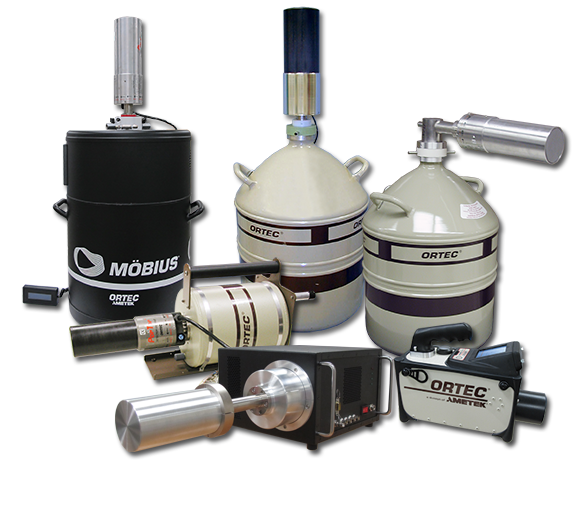Semiconductor based photon radiation detectors have been evolving for over half a century, with ORTEC pioneering commercial availability for a majority of that time. Initial offerings were based around lithium-drifted germanium Ge(Li) and lithium-drifted silicon Si(Li). Ge(Li) was later replaced with more advanced, high purity germanium (HPGe) detectors. ORTEC provides a comprehensive suite of HPGe detector solutions covering an extensive range of energies and for a variety of applications.
Cryogenic cooling is required for germanium semiconductor radiation detectors. In order to support various counting geometries, ORTEC offers a wide range of cooling options ranging from standard LN2 systems, to advanced electro-mechanical cryocoolers such as the ICS™.
These technologies enable ORTEC HPGe radiation detectors to be used world-wide in applications as diverse as nuclear structure physics to the prevention of illicit nuclear materials trafficking at the world's largest ports of commerce.
HPGe Radiation Detector Types and How to Choose

Categories of High Purity Germanium (HPGe) Radiation Detectors
ORTEC offers a wide range of HPGe radiation detector solutions which cover energies for X-rays in the few hundred electron volts (eV) range up to gamma rays in the 10 MeV and above range. These detectors are manufactured using high purity germanium (HPGe) of both P- and N-type. All detectors in these two classes are cryogenically cooled, using either liquid nitrogen or electro-mechanical coolers.
How to Choose the Right HPGe Radiation Detector for Your Application
Choosing the correct detector for your specific application involves many criteria. No single table or graph can uniquely specify a detector for a particular measurement. The energy range chart above, and the key attribute table below should provide an excellent start in making the right choice. You can click the detector type link in the table below for more details regarding that specific detector.
ORTEC also has several unique detectors that are application specific as well as the capability to design and manufacture specialty detectors. Select the links below for more details.
|
FWHM Resolution (in keV) @ Specified Energy |
|||||
|
Detector Series |
Typical Counting |
Relative Efficiency |
5.9 keV |
122 keV |
1332 keV |
|
GEM |
Point source |
10-150 |
n/a |
0.80-1.30 |
1.75-2.30 |
|
Profile C |
Point source |
20-175 |
0.73-1.23 |
0.85-1.30 |
1.80-2.30 |
|
Profile M |
Point source |
20-175 |
n/a |
0.88-1.30 |
1.80-2.20 |
|
Profile S |
Point source |
7-65 |
0.35-0.50 |
0.65-0.70 |
1.80-1.90 |
|
Profile SP |
Point source |
7-50 |
0.30-0.43 |
0.59-0.63 |
1.80-1.90 |
|
Profile F |
Point source |
7-60 |
n/a |
0.65-0.85 |
1.80-2.10 |
|
GMX |
Point source |
10-100 |
0.60-1.20 |
n/a |
1.80-2.5 |
|
GLP |
Point source |
n/a |
0.17-0.39 |
0.48-0.60 |
n/a |
|
GWL |
Small volume source |
90-450 cc |
n/a |
1.20-1.40 |
2.10-2.30 |
| Application | Most Suitable Detector(s) |
| Synchrotron light studies; Soft X-ray (fusion) research | GLP |
| Large environmental samples with complex spectra | GEM, GEM-F, GEM-M, GEM-C, GEM-S, (low-background recommended) |
| Environmental samples on filter media, dishes or bottles | GEM-F, GEM-C, GEM-S, GEM, GMX |
| Small environmental samples | GWL (low-background recommended) |
| High-grade fissile materials / Safeguards | SGD, SGD-GEM |
| Neutron activation analysis | GMX (PLUS option recommended) |
| Post-accident monitoring | GEM (PLUS option recommended) |
| Compton-suppressed gamma spectroscopy | GMX |
| Sea or airborne surveillance | Micro-trans-SPEC, trans-SPEC-DX-100T, IDM-200-V |
| Lung monitoring | GEM-S, Actinide-85 |
| Measurements in-beam or near fast-neutron fields | GMX (special internal heater for in-situ neutron damage anneal recommended) |
| Waste assay | Micro-trans-SPEC, trans-SPEC-DX-100T, GEM, GMX, GEM-C, GEM-S, IDM-200-V |
| Freight / Border Security | Micro-Detective, Detective-EX, Detective-DX, Detective-200, IDM-200-P, IDM-200-V |
| In-Situ environmental spectroscopy | Micro-trans-SPEC, trans-SPEC-DX-100T, GEM, GMX, GEM-C, GEM-S, IDM-200-V |

